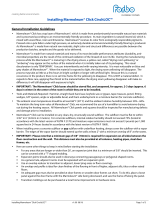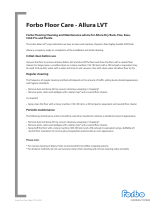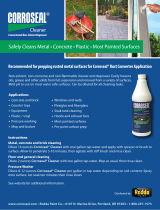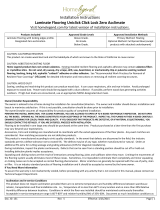
Click Panel Dimensions .......12” x 36” approx. (300mm x 900mm)
Click Square Dimensions .......12” x 12” approx. (300mm x 300mm)
Structure:
Total Thickness .......9.8mm
Surface .......2mm Marmoleum®
Base Material ......6.8mm HDF
Backing ......1mm cork
Carton Contents ......7 panels for 20.3 sq. ft. (1.89m
2
)
......7 squares for 6.7 sq. ft. (0.63 m
2
)
general installation guidelines
Marmoleum® Click Cinch Loc has a top layer of Marmoleum®, which is made
from predominantly harvestable natural raw materials and is processed
according to an environmentally friendly procedure. Its main ingredient is
natural linseed oil, which is mixed with wood our, rosin and limestone. Mar-
moleum® receives its color from ecologically responsible pigments. Pressed
onto a jute fabric under high pressure, an extremely durable and environ-
mentally friendly ooring is produced. As Marmoleum® is made from natural
raw materials, slight color and structural dierences are possible between the
production batches, samples and the goods to be delivered.
IMPORTANT: The Marmoleum® Click Cinch Loc boxes should be stored at, and
unopened, for approx. 2-3 days (approx. 6 days in winter) in the center of the
room in which they are to be installed.
· Tools and Materials Required: Hammer, straight back hand saw, keyhole saw or
jigsaw, tape measure, pencil, tting wedges, 3/8” spacers, angle or adjustable
bevel, and foam underlayment or a moisture barrier (for concrete suboors).
· The ambient room temperature should be at least 68° F (20° C) and the ambi-
ent relative humidity between 50% - 60%. To maintain the long term value of
Marmoleum® Click Cinch Loc, we recommend the use of a humidier to avoid
extreme drying out during the heating season. All Marmoleum® Click Cinch Loc
panels and squares should be inspected for manufacturing defects and damage
prior to installation.
· Marmoleum® Click Cinch Loc can be installed on any clean, dry, structurally
sound suboor. The suboor must be at to within 3/32” in 6’ (2.0mm in 2
meters). For concrete suboors, internal relative humidity should not exceed
75% (tested in accordance with the latest version of ASTM F 2170) and moisture
vapor emissions must not exceed 3 pounds per 1,000 square feet in 24 hours
(tested in accordance with the latest version of ASTM F 1869).
· When installing over a concrete suboor or any suboor with underoor
heating, always cover the suboor with a vapor barrier. The edges of the vapor
barrier should extend up the walls at least 2” with a minimum overlap of 8” at
the seams.
IMPORTANT: Please note that a minimum gap of 3/8” (10mm) is required for
expansion on all sides between the oor construction and the wall. This distance
must also be provided at all columns, heating pipes, steel door
frames, etc.
Here are some other things to keep in mind before starting the installation:
For any areas that are longer or wider than 26’, an expansion joint that is a
minimum of 3/8” should be inserted. This can be covered with a “T” shaped
molding. Expansion joints should also be used in doorways connecting pas-
sageways or polygonal-shaped rooms. As a general rule, adjacent rooms must
be separated with an expansion joint. Use an overlap reducer to transition to
adjacent, lower lying areas or oor coverings. An overlap end prole is ideal
for clean nishes of the ooring in front of higher, adjacent sills, tiles or other
raised oors.
An adequate gap must also be provided at door frames or wooden door
frames cut short. To do this, place a loose panel against the door frame with
the Marmoleum® side facing downward, and saw the frame o along the
panel.
Transition moldings can be purchased at a local home improvement or hard-
ware store.
· Marmoleum® Click Cinch Loc is resistant to water, but it is not waterproof.
It is important to minimize any opportunity for damage by cleaning spills
immediately. It is also very important to take measures during the installation
that will prevent water or moisture from getting underneath the Marmoleum®
Click Cinch Loc.
If a oor drain or sump pump is present, it is there for a reason. DO NOT
INSTALL Marmoleum® Click Cinch Loc on that level.
All expansion spaces located in wet areas, such as areas where sinks dishwash-
ers, refrigerators, toilets, showers, bath tubs are located should be sealed with
100% mildew-resistant silicone. To seal the area, apply a thin bead of silicone
where the bottom of the Marmoleum® Click Cinch Loc and suboor meet. DO
NOT ll the entire expansion space with silicone. Spills should not remain on
the surface of Marmoleum® Click Cinch Loc longer than 30 minutes.
· For additional information, contact Forbo’s Product Support and Education
Services.
installation
Marmoleum® Click Cinch Loc is installed without any need for glue by plac-
ing the tongue into the groove as well as the
groove into the tongue; however it is easier to
work so that you are placing the tongue into
the groove. The GROOVE is the prominent vis-
ible locking piece on two sides of the material,
shown on the right and bottom in Figure 1. The
TONGUE is semi-hidden on the other two sides
of the material, shown on the left and top in
Figure 1.
1. Inspect each piece for damage prior to instal-
lation.
8
installation

2. Start by measuring the room and determining the starting point
in the room. It is recommended to install the material
perpendicular to the incoming light from the main window. This
will help minimize the appearance of the seams throughout the
room.
3. Lay out several pieces with the groove side facing right.
4. To ensure that all pieces are clicked together at exact 90° angles,
install a temporary piece along the front wall (parallel with the
material). Click the tongue of the rst piece into the groove of
the temporary piece, allowing the temporary piece to sit halfway
on the rst piece. See Figure 2. The temporary piece in the gure
is the top piece.
NOTE: The pieces must be perfectly aligned with one
another. Any variation in alignment from piece to piece can
create gaps between one row and the next.
5. Place the tongue of the second piece into the groove of the
temporary board at a 45° angle. See Figure 3.
6. Slide it gently to the left. Lower it into the groove of the rst
piece and press it into place. You should hear a clicking sound
when it locks into place.
7. Move the temporary board so it now sits halfway on the second
piece. See Figure 4.
8. Continue these steps until the end of the row.
9. Before laying the nal piece, remove the temporary board and
place spacers that are 3/8” wide along the length of the front wall
as well as the left side wall.
10. Slide the entire rst row so it is touching the spacers. Measure
9
the distance from the edge of the last piece to the wall. Subtract
3/8” and cut the nal piece to t. Be sure to cut the piece so that
the cut edge will be touching the wall when it’s installed.
NOTE: If using a hand saw, the Marmoleum® side must be
facing upwards. If using a power saw, the direction of the blade must cut into
the Marmoleum® side of the board
(Marmoleum® side facing downwards).
11. Move the row away from the wall and with the use of a temporary board,
install the nal piece to the row.
12. Carefully slide the row back to the wall and place a 3/8” spacer at the right
side wall.
13. When installing Marmoleum® Click Cinch Loc panels, the joints of these
pieces must be staggered a minimum of 12”. It may be
necessary to cut the rst piece of the row to create this stagger. This same
stagger can be created by mixing both panels and squares throughout the
installation. Marmoleum® Click Cinch Loc squares can be installed with all 4
corners touching, or in a checkerboard pattern.
14. Start installing the second row to the rst row as outlined above in Steps
5 – 7. The rst row is used in place of the temporary piece.
15. The remainder of the room is installed following these steps. If there are
any other xed objects in the room, such as cabinets, pipes, etc., it is important
to leave a minimum of 3/8” spacer where the ooring meets these objects.
16. For the nal row, be sure to leave a minimum of 3/8” spacer at all walls. The
bottom groove that will be against the wall can be sawed o if necessary.
17. For areas where there are door moldings or other obstructions that the
material must slide under, remove the groove
from the previous row. Then, instead of clicking the nal row into place, it will
be slid into place. These areas must be secured using wood glue where the
tongue and groove would meet.
18. After the nal row is in place, molding, such as a quarter round, is installed
to cover the expansion perimeter around the room.
19. If for any reason you need to disassemble the oor, gently remove the nal
row and take the pieces apart starting from the last board on the right.
20. The oor can be walked on immediately after installation.

10
Marmoleum® Click Cinch Loc has a strong, durable protective top layer – Top-
shield™2. This innovation from Forbo ensures a highly eective shield against
dirt and scu marks. Marmoleum® with Topshield™2 is ready for use immedi-
ately following installation and does not require the application of additional
protective coats of nish. With Topshield™2, your Marmoleum® oor will main-
tain its beautiful appearance with simple cleaning. Dry dusting is a fast and
easy way to keep your oor free from loose dirt. Remove spots with a mop or
cloth dampened with diluted Forbo Neutral pH Cleaner. Avoid excessive use
of water on the oor, and make sure chair and furniture
legs are covered with felt protectors. An entrance mat
will protect the oor from dirt.
Initial Care Following Installation
1. Remove all surface soil, debris, sand and grit by sweeping, vacuuming or
dust mopping.
2. Mix 1/2 – 1 ounce of Forbo Neutral pH Cleaner per 1 gallon of unheated
tap water.
3. Apply the solution to the oor. Do NOT ood the oor. The solution can
be applied with a mop and bucket.
4. Pick up soil and excess solution with a clean mop. Rinse mops frequently
and change the solution as needed.
5. Rinse the entire oor surface with a clean mop using clean, cool water. Pick
up rinse water with a clean, dry mop or towel.
6. Allow the oor to dry thoroughly before allowing trac.
Routine Floor Care Procedures
1. Remove all surface soil, debris, sand and grit by sweeping, vacuuming or
dust mopping.
2. Mix 1/2 – 1 ounce of Forbo Neutral pH Cleaner per 1 gallon of unheated
tap water.
3. Apply the solution to the oor. Do NOT ood the oor. The solution can
be applied with a mop and bucket.
4. For ingrained dirt, a non-abrasive scrubbing sponge may be required.
5. Pick up soil and excess solution with a clean mop. Rinse mops frequently
and change the solution as needed.
6. Rinse the entire oor surface with a clean mop using clean, cool water.
Pick up rinse water with a clean, dry mop or towel.
7. Allow the oor to dry thoroughly before allowing trac.
Spots & Spills
The vast majority of spills can be cleaned o your Marmoleum® satisfactorily.
If there are spills or pet “accidents”:
1. Act quickly.
2. Scrape or blot as much as possible.
3. Mop the oor with a solution of Forbo Neutral pH Cleaner.
4. Damp mop with clean water.
5. If necessary, repeat steps 3 and 4. If the stain persists, as it may with glue,
varnish, paint, ink, tar, cosmetics, shoe polish, some wines, coee and
some other substances, you may need to allow the solution to sit or “dwell”
on the oor for several minutes. Rub the stained area with a green nylon
kitchen pad then rinse the area with clean water. Repeat if necessary.
If the stain persists, contact Forbo Product Support & Education Services
before trying any other procedures.
For further information on restoration, please contact Forbo’s Product
Support & Education Services at +1-800-842-7839.
caring for your oor
933858 barbados, 933872 volcanic ash
-
 1
1
-
 2
2
-
 3
3
Ask a question and I''ll find the answer in the document
Finding information in a document is now easier with AI
Related papers
Other documents
-
 Forbo Marmoleum Click Cinch LOC 184869 Installation guide
Forbo Marmoleum Click Cinch LOC 184869 Installation guide
-
Home Decorators Collection ALX17515K01 User guide
-
Home Decorators Collection ALX17217K01 User guide
-
 Forbo Marmoleum Click Cinch LOC 201237 User manual
Forbo Marmoleum Click Cinch LOC 201237 User manual
-
Numatic MMB1616 Owner Instructions
-
 Forbo Allura LVT 231200 User manual
Forbo Allura LVT 231200 User manual
-
 Corroseal 800332 User manual
Corroseal 800332 User manual
-
 HOMELEGEND HL1220-48 Installation guide
HOMELEGEND HL1220-48 Installation guide
-
Home Decorators Collection HL1324 Installation guide
-
Home Decorators Collection HL634H Installation guide










